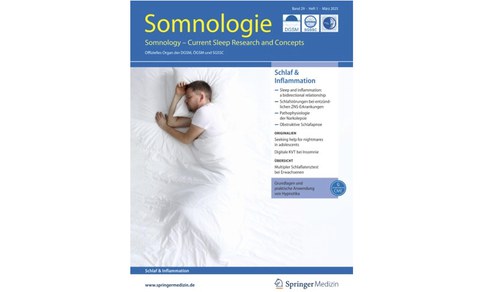08.05.2025
Neue Publikation im Fachmagazin „Somnologie“
Ein ZMI-Team bestehend aus unserem wissenschaftlichen Mitarbeiter Franz Ehrlich, der als Hauptautor fungiert, Dr. Miriam Goldammer, unserer Leiterin des Forschungsbereichs Data Science, und Prof. Dr. Martin Sedlmayr hat im Fachmagazin „Somnologie“ einen Artikel mit dem Titel „Bewertung von KI-Algorithmen für die klinische PSG-Auswertung am Beispiel der Apnoe-Erkennung“ publiziert.
Die manuelle Auswertung von Polysomnographien (PSG) ist zeitaufwändig und subjektiv. Künstliche Intelligenz (KI) bietet hierbei vielversprechende Möglichkeiten, um diesen Prozess zu automatisieren und zu unterstützen.
Im vorliegenden Artikel werden zunächst die Grundlagen des maschinellen Lernens in der Schlafauswertung, einschließlich des überwachten Lernens und der Bedeutung einer adäquaten Datentrennung erläutert. Eine Darstellung der zentralen Anforderungen an Datenqualität und Datenvielfalt für die praktische Anwendung im Schlaflabor schließen sich an. Der Beitrag unterstreicht die Bedeutung geeigneter Bewertungsmetriken und die Wichtigkeit der Untersuchung der Klassifikationsgüte in verschiedenen Patientengruppen.
Ausgehend von diesen Anforderungen wird ein Überblick über aktuelle Algorithmen zur automatisierten Apnoe‑/Hypopnoe-Erkennung gegeben. Trotz Fortschritten in der automatisierten Erkennung gibt es noch keine vollständig evaluierten Algorithmen, die eine manuelle Beurteilung ersetzen können. Dieser Artikel soll dazu beitragen, aktuelle Algorithmen zu bewerten und Anforderungen an die zukünftige Entwicklung von KI-Algorithmen in der Schlafmedizin zu formulieren.
Die vorliegende Veröffentlichung gehört zu unserem Anwendungsschwerpunkt Schlafforschung und Schlafmedizin und damit auch zum MII-Forschungsprojekt Somnolink - Connected sleep data and decision support along the patient path for better care of Obstructive Sleep Apnea, das darauf abzielt, die Diagnose, Behandlung und Therapietreue bei obstruktiver Schlafapnoe (OSA) zu verbessern. Da für die fruchtbringende Erstellung funktionsfähiger Algorithmen zahlreiche nutzbare Daten aus möglichst verschiedenen Klinken benötigt werden, bedarf es für die Entwicklung multizentrische Studien wie Somnolink, die mit Daten von hoher Quantität und Qualität aufwarten.
Zum vollständigen Artikel gelangen Sie hier:
https://link.springer.com/article/10.1007/s11818-025-00505-7

